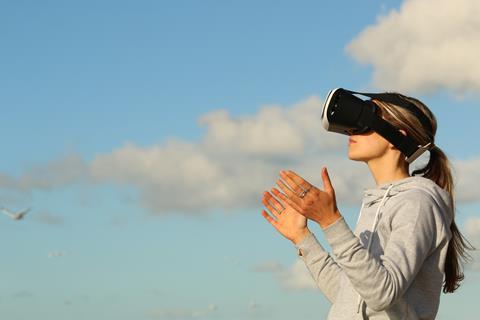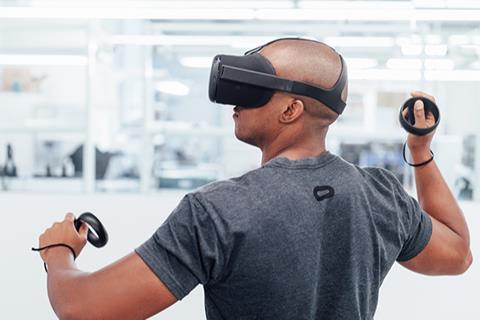The VR sector is now going through a much-needed period of readjustment after inflated early expectations about the technology.

Virtual reality is one of the many technologies to have been boosted by Covid-19 lockdowns, enjoying an uplift in spending as stuck-at-home consumers looked for alternative means of entertainment.
Content spend on VR will have surpassed $1bn by the end of 2020, with 6.4 million consumer headsets sold during the year, according to new research by market analyst firm Omdia.
Crossing the $1bn mark is a notable milestone for the VR sector, which has struggled to live up to high levels of hype about its future.
Nevertheless, it’s worth putting this figure into perspective. Omdia reckons household penetration of VR headsets will be a mere 1.2% this year across the leading 32 countries in its research. Sales this year has been limited by manufacturing challenges in the first half of 2020 due to Covid-19, while the November launch of next gen Xbox and PlayStation games consoles has diverted gamer’s attention and budgets.
The report’s author, Omdia senior analyst George Jijiashvili, says the VR sector is now going through a much needed period of readjustment after inflated early expectations about the technology.
“Soon we may well see immersive become part of everyday life, and one day perhaps as ubiquitous as the smartphone.” Damian Collier, Blend Media
He believes the market will continue to expand, albeit at a slower rate than previously anticipated. By 2025, 45m headsets will be actively used by consumers, who will spend $4bn on VR games and other media. This will translate into a 3% household penetration of headsets by 2025, highlighting the long road ahead for the mass adoption of VR.
This is despite the launch this year of the well-received and high quality Oculus Quest 2 headset, which now starts at a relatively affordable £299.

Jijiashvili tells IBC365 there are three key reasons why VR is not growing faster.
Firstly, and crucially, there is a limited choice of truly compelling content for VR compared to console, PC and mobile gaming.
“VR games such as Beat Saber have become a well-recognised phenomenon, which have broadened the appeal of VR beyond gaming enthusiasts,” says Jijiashvili. “Unfortunately, however, games like that are still few and far between.”
A classic chicken and egg situation is holding the market back. Game makers do not want to invest heavily in VR because of the small number of households with headsets. Consumers, meanwhile, are holding off buying headsets because of the lack of compelling content.
Initially most tech giants and major hardware manufacturers dabbled in VR, but their interest has waned over the years. There have also been many casualties in the VR production space, including BBC VR Hub, Google Spotlight Stories, Jaunt and Oculus Studio Story. The only major company really focused on VR is Oculus-owner Facebook, which over the past year has acquired Beat Saber publisher Beat Games, Sanzaru Games and Ready at Dawn.
“Facebook has placed its money where its mouth is, resulting in hugely positive developments, nudging VR closer to the mainstream audience. What VR now desperately needs is more commitment of this scale from other leading Western and Eastern tech companies,” says Jijiashvili.
Secondly, long term user retention is still a challenge for VR, particularly for slot-in smartphone VR and PC/console tethered VR headsets. This is mainly because they have a lot of ‘friction’ for users, including the time consuming steps required to start experiencing VR. However, headsets such as the Quest are helping to reduce this friction; the standalone version just needs to put on the head, and it quickly starts up. “That is what we need more of,” says Jijiashvili, who estimates that 1.2m units of Quest devices will be sold in 2020, growing to 5.6m units in 2025.
Facebook’s aggressive loss-leader strategy has meant that other headset manufacturers simply can’t compete, leading to many shifting their focus to the adjacent enterprise VR category. Omdia forecasts Facebook’s share of global standalone VR headset sales reducing from 48% in 2020 to 35% in 2025. Elsewhere, Valve’s PC-tethered Index headset has resonated well with gamers, while HTC is seen to be losing ground to Oculus and Valve after being unable to replicate the initial success of Vive with its new Vive Cosmos headsets. Sony, meanwhile, recently said the follow up to the PlayStation VR will not arrive in 2021.
“It’s not cinema, it’s not TV, or watching stuff on your phone. It is another way of expanding the medium.” Asif Kapadia, documentary maker
Thirdly, and importantly, the ubiquity of video gaming makes it very hard for VR to compete. “The availability of a huge library of games on consoles, PC and mobile means gaming is easily accessible on devices people already own – at either very low cost or even free, thanks to free-to-play games,” says Jijiashvili.
It’s not just console, PC and mobile video games that are vying for VR users’ time and attention, but platforms such as Netflix and YouTube through to Instagram and TikTok.
It’s a point that is recognised by this writer. Our family took delivery of an Oculus Quest 2 in October, soon after it launched. It’s a wonderful piece of kit – simple, intuitive and exciting to use. But there is precious little great content to play or to watch. For our teenage kids, the Xbox, Netflix or their smartphone are still more compelling. By comparison, the Quest is picked only very occasionally.
Jijiashvili reckons that games will account for 90% of total spend on VR content in 2025. In terms of video, he expects monetisation to be driven by advertising and media subscriptions, as exemplified by YouTube and Netflix’s approach to VR. Social VR is another category which has shown potential, but it has experienced similar challenges to interactive video. Facebook remains strongly committed to its long-term vision for its Horizon platform, but it remains to be seen if it can create a truly compelling social experience in VR.
“Facebook has placed its money where its mouth is, resulting in hugely positive developments, nudging VR closer to the mainstream audience.” George Jijiashvili, Omdia
Within the industry, there remains optimism about the future of VR. In October, immersive content provider Blend Media launched freelancer marketplace Blend Market, a platform that connects brands and businesses with skilled VR creators and creative solutions.
As well as games and video, Blend has its eye on the immersive business application market. Blend Media founder and CEO Damian Collier says immersive technology is a “transformative, high growth” industry relevant to every business sector. “We see clients coming to Blend with projects ranging from VR training for enterprise, AR filters for music artist album promotions and game launches, to VR content in healthcare for dementia, cancer and other patients.”
Hardware and software developments, he says, are driving the industry forwards. “Soon we may well see immersive become part of everyday life, and one day perhaps as ubiquitous as the smartphone.”

Elsewhere, compelling video content is slowly but surely emerging – with big names involved in production. Collier cites the October release of Micro Monsters, the new five-part VR documentary narrated by David Attenborough which debuted on Oculus Quest in October.
Featuring a scorpion and centipede going to battle – to the death – and a caterpillar’s transformation from inside the cocoon, Micro Monsters was produced by Alchemy Immersive using specially-developed 3D stereoscopic camera rigs, 180 live-action capture and newly-developed VFX compositing techniques. “The use of space and the spatial sound design is outstanding,” says Collier. “I guarantee you will not be able to get closer to these bugs if you try.”
Meanwhile, Academy Award and Bafta winning Asif Kapadia (Diego Maradona, Senna, Amy) is making his first foray into immersive filmmaking with short film Laika, which tells the story of the first Space Dog, in collaboration with animation studio Passion Pictures.
Kapadia says he started out as a cynic about VR. “I wear glasses, I get migraines, I’ve got really bad stigmatism. I remember finding it all not particularly comfortable.”
Then he was asked to make Laika as a commission from the BFI London Film Festival and StoryFutures Academy . “I just like experimenting. I was asked to be on the jury at Venice this year, for the VR section. I saw some amazing work. And that’s when I realised, okay, this is really the next step of how to push the entertainment industry and the business to another level.”
“I’m a convert now,” says Kapadia. “It’s not cinema, it’s not TV, or watching stuff on your phone. It is another way of expanding the medium. There are certain films, if done right, that work perfectly in that form. And they could not be done in any other way.”
- Read more: Nvidia the metaverse is coming
























No comments yet